Japan
Wood Products Prices
Dollar Exchange Rates of 25th
October
2025
Japan Yen 152.87
Reports From Japan
Fight against inflation the top priority
Prime Minister Sanae Takaichi devoted her first policy
speech on her suggestions for boosting Japan’s economy
and tackling inflation along with her plans to make Japan
more assertive on security. More than half of the 20-page
speech was dedicated to economic policies. Takaichi made
the case for fiscal expansion to create a strong economy,
describing the fight against inflation as the top priority of
her administration. “In order to build a strong economy,
we will implement strategic fiscal spending under the
approach of responsible and proactive fiscal policy,”
Takaichi said in parliament.
See:
https://www.japantimes.co.jp/news/2025/10/24/japan/politics/tak
aichi-first-policy-speech/
Bank of Japan - interest rate unchanged
The Bank of Japan (BoJ) Policy Board met in late October
at a time when consumer prices, excluding fresh food, rose
2.9% from a year earlier in September, up from 2.7% in
August and accelerating for the first time in four months,
according to the Ministry of Internal Affairs. Despite this
the BoJ left its benchmark interest rate unchanged.
The pace of inflation would appear to have support an
interest rate increase by the BoJ. The Consumer Price
Index, the main inflation related data, has hovered around
the BoJ’s 2% target for three and a half years.
However, Taro Saito, Head of Economic Research at NLI
Research Institute, suggested that the main driver of core
inflation was the impact from last year’s bigger energy
subsidies and this was not enough justification for a BoJ
rate increase.
Utility subsidies have been implemented to help
households cope with the hottest summer on record from
July to September. But its impact on inflation figures
generally has a lag of a month and the scale of this year’s
electricity subsidies was about 40% smaller than last
year’s.
BoJ Govenor, Kazuo Ueda, highlighted food inflation as
one of three factors to watch in deciding the timing of the
bank’s next rate increase along with the US economy and
the impact of US tariffs.
Signs of recovery in private consumption
Japanese household spending rose at a faster pace than
expected in August government data showed, with
consumers feeling relatively optimistic, a promising sign
for the recovery in private consumption. Consumer
spending rose 2.3% from a year earlier, up for the fourth
consecutive month.
An increase in travel and transportation expenditure, partly
a reflection of pent-up demand from the same month last
year, contributed to the rise in spending.
Consumption and wage trends are also among key factors
the BoJ is monitoring to determine the timing of the next
rate hike.
See: https://www.reuters.com/world/asia-pacific/japan-august-
household-spending-rises-23-yearyear-2025-10-06/
Consumer confidence indices all positive
Japan’s consumer confidence index rose to 35.8 in
October 2025 from 35.3 in September, surpassing market
forecasts. All components improved: overall livelihood
(34.3 vs 33.2 in September), income growth (40.0 vs
39.4), employment outlook (40.1 vs 39.9) and willingness
to buy durable goods (28.9 vs 28.8)
See: https://tradingeconomics.com/japan/consumer-
confidence/news/496964
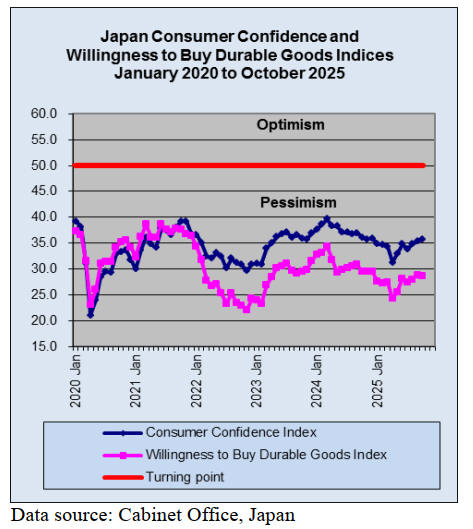
Union to demand minimum 5% wage increase
The Japan Trade Union Confederation, also known as
Rengo, has announced its decision to demand a wage
increase of at least 5% in the 2026 spring annual labour-
management negotiations, maintaining the same target as
this year to sustain momentum amid persistent inflation.
In its basic policy for the 2026 "shunto" wage talks Rengo
said it aims for a real wage increase of 1%. Rengo also
said it will seek a minimum hourly wage of 1,300 yen or
higher, up from this year's negotiations.
In the 2025 negotiations, Japanese firms agreed to raise
wages by an average of 5.25% marking the second
consecutive year that exceeded 5%.
See:
https://mainichi.jp/english/articles/20251024/p2g/00m/0bu/0140
00c
Weak yen a headache for policymakers
Japan's new Economic Revitalisation Minister, Minoru
Kiuchi, said a weak yen benefits the economy and its
demerits could be addressed by swiftly compiling a
package of steps to ease the pain from rising living costs.
He also said the new administration's priority would be to
accelerate economic growth so that the benefits of
recovery can be delivered to the broader population. These
remarks highlight the focus of the new administration on
reflating the economy through expansionary fiscal
policies.
The weak yen has become a political headache for
policymakers in Japan as it pushes up import costs and
broader inflation. The BoJ's exit from a decade-long,
massive stimulus in 2024 and two interest rate hikes came
amid political calls for action to combat sharp exchange
rate declines.

Rural and urban house price disconnect
Key issues in Japan's housing sector include a shrinking
and aging population leading to a rise in the number of
vacant homes, particularly in rural areas. At the same time
there is currently a boom in prices in urban centres due to
limited supply and investment from wealthy individuals
and foreign buyers.
Other major challenges are the increasing cost of
construction due to material and labour price hikes and
potential government intervention to control the market.
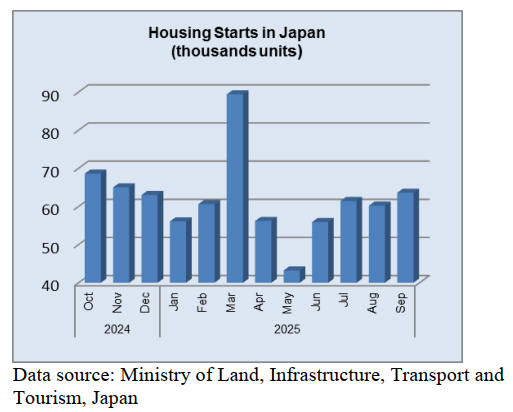
Housing complex for foreign workers in Niseko
Hokkaido authorities have approved converting farmland
in Kutchan Town to construct a large shared housing
complex for around 1,200 foreign workers in
the Niseko resort area. Niseko is one of the world's top ski
destinations.
The prefectural government said the developer's plan met
legal and environmental standards, with minimal impact
on nearby farmland. The town expects the complex to
accommodate up to 1,200 foreign workers employed at
local resorts during the winter season. That number is
equivalent to nearly 10% of Kutchan's population of about
14,000 as of August.
https://japan-forward.com/hokkaido-approves-massive-foreign-
worker-housing-project-despite-concerns/
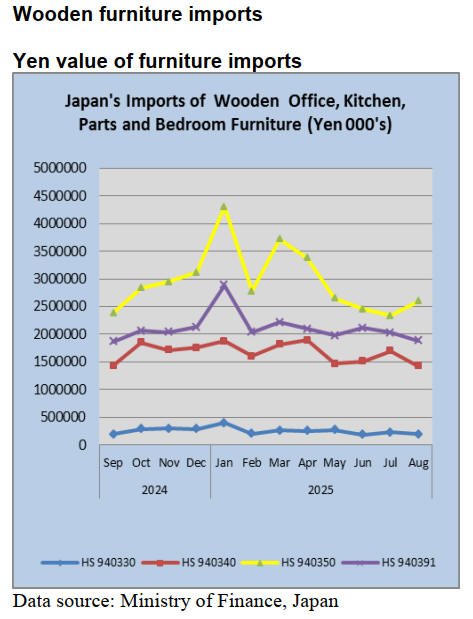
Wooden office furniture imports (HS940330)
In August two shippers, China and the UK accounted for
91% of Japan’s imports of wooden office furniture
(HS940330). August marked the first time the UK
appeared in Customs data as a major shipper. The other
main shipper in August was Germany. In August, shippers
in China accounted for 84% (79% in July) of Japan’s
imports of wooden office furniture. Year on year, the
value of Japan’s imports of wooden office furniture in
August declined as it did month on month.
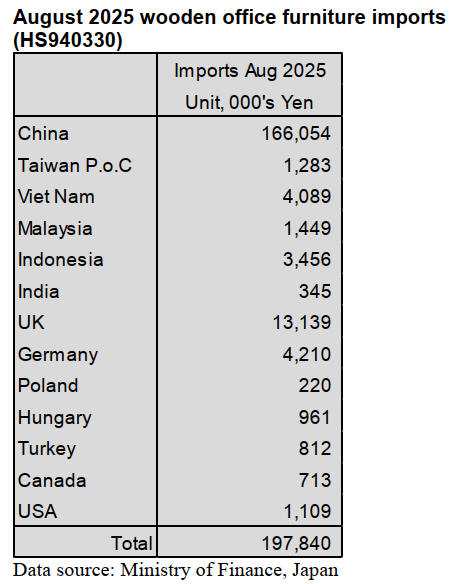
Wooden kitchen furniture imports (HS940340)
Year on year the value of wooden kitchen furniture
imports was at around the same level as in August 2024
but compared to a month earlier the value of imports
declined after two months of increase.
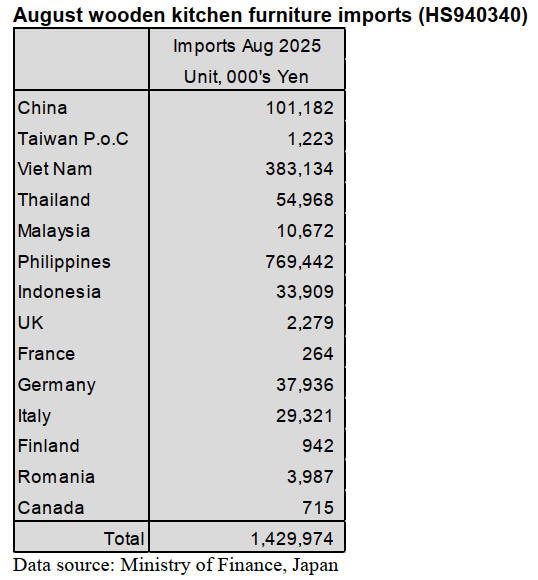
As in previous months August imports of wooden kitchen
furniture (HS940340) were dominated by shippers in the
Philippines (54% of HS940340 imports) and Viet Nam
(27% of HS940340 imports). August arrivals from both
the Philippines and Viet Nam declined compared to a
month earlier. The value of August arrivals from China
(7% of the total) was below that reported in July.
In August there were significant shipments originating in
Thailand, Germany, Indonesia and Italy.
Wooden bedroom furniture imports (HS940350)
After the four consecutive months of decline the value of
wooden kitchen furniture imports rose 11% in August
back to the same level as seen in the first quarter of the
year but still well below the average for the past eight
months.
The top two shippers of HS940350 to Japan in August
were China, 59% (64% in July) and Viet Nam 29% (29%
in July). Shippers in Malaysia improved their market share
to 4% of imports compared to 2.5% in July. The other top
sources of August imports were Thailand, Indonesia,
Poland and Italy.
Year on year there was an 7% increase in the value of
August imports and an 11% increase compared to a month
earlier.
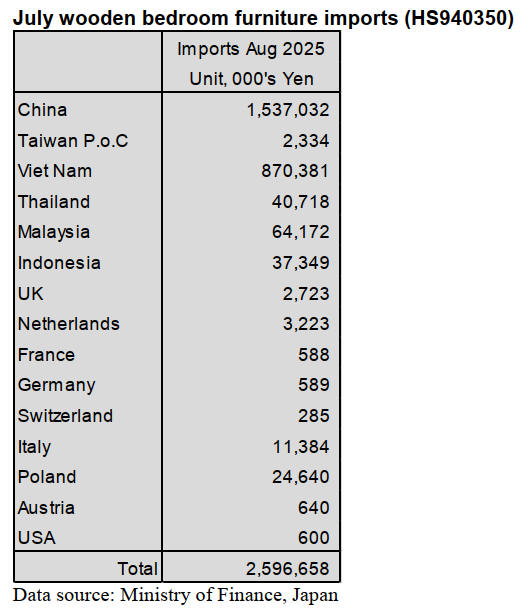
Wooden furniture parts imports (HS940391)
Apart from the spike in the value of wooden furniture
parts (HS940391) imports in January the monthly value of
imports of wooden furniture parts remained steady up to
June but thereafter there has been a slight decline.
The value of August 2025 imports was slightly lower (7%)
than reported in July but compared to August 2024 there
little change.
Shippers in China and Viet Nam accounted for most
(61%) HS940391 imports in August 2025. The value of
imports from China dropped compared to July while the
value of imports values from Viet Nam remained at
around the same level as in July.
Of the total value of HS940391 imports, 47% was
delivered from China (46% in July), 20% from Indonesia
(18% in July), 14% from Viet Nam (12% in July).
Malaysia, which secured an 7% share of July imports, was
the fourth ranked source in terms of value. Imports of
HS940391 from Germany Italy and Hungary declined in
August mainly because of EU factory closures for
holidays.
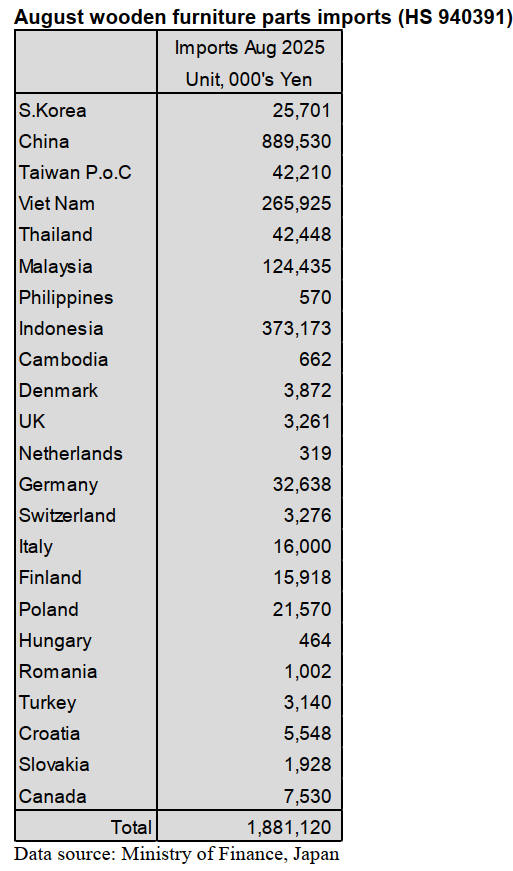
Trade news from the Japan Lumber Reports (JLR)
The Japan Lumber Reports (JLR), a subscription trade
journal published every two weeks in English, is
generously allowing the ITTO Tropical Timber Market
Report to reproduce news on the Japanese market
precisely as it appears in the JLR. For the JLR report
please see: https://jfpj.jp/japan_lumber_reports/
Japan’s forestry budget targets timber growth
The Forestry Agency has requested ¥345.762 billion for
fiscal 2026, a 12.7% increase from the previous year’s
initial budget.
The proposal emphasizes achieving net-zero
emissions by
2050, addressing pollen-related health concerns, and
advancing the “Forest Nation, Wood City” vision. The
allocations include ¥231.7 billion for public works such as
forest maintenance and erosion control, and ¥114.012
billion for non-public projects, maintaining a 2:1 funding
ratio.
The budget highlights four priority areas: green growth in
forestry and wood industries, forest conservation, erosion
control, and rural revitalization. Notable increases include
¥18.2 billion for green growth initiatives and ¥148.5
billion for carbon sink enhancement and wildfire
prevention.
It also includes ¥1.1 billion for pollen-related measures
and requests tax revisions to support forest management
and fuel cost relief.
Acquisition of shares in French plywood manufacturer
Nankai Plywood Co., Ltd. in Kagawa Prefecture
announced its full acquisition of shares in a French
company engaged in plywood manufacturing. As part of
the deal, the company and its four subsidiaries will
become consolidated subsidiaries, while one equity-
method affiliate will be added to Nankai’s equity-method
affiliates.
The Joubert Group, whose shares are being acquired in
this transaction, is the second-largest plywood
manufacturing group in France. The group includes two
subsidiaries engaged in plywood manufacturing and sales,
one subsidiary involved in veneer production, one equity-
method affiliate, and one subsidiary dedicated to
afforestation.
The company's strength lies in the high quality of its
manufactured plywood, which is primarily made from
okoume and poplar wood species. For the fiscal year
ending December 2024, consolidated net sales amounted
to ¥12.708 billion, based on an exchange rate of ¥170 per
euro. The company also aims to utilize the acquisition as a
sales channel for construction materials such as LVL,
which are scheduled to be produced by its Indonesian
subsidiary, thereby enhancing profitability.
Plywood
Since September, domestic softwood plywood has seen
some improvement in distribution activity, but real
demand remains sluggish due to stagnation in new housing
starts.
Major plywood manufacturers continued to strengthen
their intention to raise prices in September for
domestically produced structural softwood plywood (12
mm thick, 3×6 size). However, amid weak demand, some
plywood manufacturers have taken a cautious stance,
resulting in a lack of alignment across the industry.
In the Tokyo metropolitan area, the prevailing price is
around ¥1,100 per sheet (delivered to wholesalers), up
approximately ¥10 from the previous month.
Shipments of imported South Sea plywood have also
generally been sluggish. Due to weak demand, price
increases have not been progressing.
Domestic prices are as follows: painted formwork
plywood (12 mm thick, 3×6 size) is ¥1,800–1,850 per
sheet (delivered to wholesalers); standard formwork
plywood is around ¥1,550 per sheet; and structural
plywood is also approximately ¥1,550 per sheet.
Standard plywood is priced approximately as follows:
¥780 per sheet for 2.5 mm thickness, ¥930 for 4 mm, and
¥1,100 for 5.5 mm (all delivered to wholesalers).
Major plywood manufacturers in Sarawak, Malaysia
appear to have reached a plateau in their price hikes
around September.
Meanwhile, standard plywood, all-natural varieties,
producers have increasingly firm in their stance. The
original prices remain flat compared to the previous
month: painted formwork plywood (12 mm thick, 3×6
size) is priced at US$600–610 per cbm (C&F), standard
formwork plywood at US$500–510, and structural
US$510–520. In contrast, standard plywood showing an
upward trend, with 2.4 mm thick (3×6 size) at around
US$970, 3.7 mm at approximately US$880, and 5.2 mm at
about US$850 (all C&F).
|